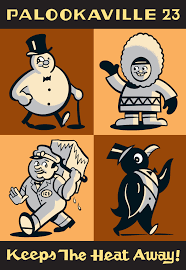Thursday Comics Hangover: A shiny new nostalgia
Even when he was getting started as a cartoonist, Seth’s comics were all about nostalgia. As a young man, his autobiographical comics depicted him as a disaffected dandy who yearned for a time before he was born — the art deco years of the 1930s. Seth spent his early middle age building a tribute to the nonexistent past that held his obsession, in the form of a timeless cardboard city called Dominion that he took on exhibition around his native Canada.
But now Seth has grown into the suits he wore as an affect when he was younger. He’s shapeshifted into the character he put on as a kid. Externally, he finally appears to be the older man he always was in his heart. And his comics, as exemplified by the 23rd issue of his one-man anthology series Palookaville, have finally grown into the nostalgia he always carried around with him. Specifically, Seth has finally lived long enough to be nostalgic for his own youth.

The first story in the new issue of Palookaville is a chapter in what appears to be an ongoing memoir about Seth’s relationship with women — or at least his attempts at romantic relationships with women. From a momentary schoolyard crush to a first attempt at making out to the first real passionate connection, Seth lays out what seems to be the beginning of an encyclopediac journey through his love life.
This sounds insufferable. It’s not, though it’s easy to see how the story could have collapsed in the hands of a less-capable writer. (At a large literary event years ago, a semi-famous Seattle literary boor/bore once read a literal kiss and tell essay about all the women he’s kissed. It treaded similar ground as this Seth piece, but it made everyone in the room want to die.) Seth handles his memoir gently and with a great deal of self-awareness. His authorial eye is less interested in the faces and bodies of the young lovers in the story as it is the haunted landscapes where the lovers exist.
With all due respect to Chris Ware, Seth is the best cartoonist in the world when it comes to laying out a sweeping vision in teeny-tiny panels. Most of the pages in Palookaville are festooned with panels the size of postage stamps — many pages have twenty panels on them, arranged in tight little grids — but when taken in aggregate, the tiny panels expand to show high school hallways or suburban towns at twilight, or barren Canadian wilderness. Seth lays the story out frame-by-frame and we examine the world of his youth, inch by inch.
This issue of Palookaville also contains the final episode of Seth’s serialized story Clyde Fans, which ends nearly twenty years after the first episode was published. The final chapter closes out with a bit of a whimper as Seth’s long-running story sheds all the whimsy of earlier episodes — a major character collected penny postcards, and earlier installments were devoted to giant novelty items as tourist traps — and instead features a very similar tone and approach to the first story in the volume: long, lonely shots of landscapes laid out in hundreds of tiny panels, with melancholy narration overlaid. It feels as though the end of one work has been swallowed by the beginning of another, and in some ways, that’s appropriate: Seth’s body of work, more than most cartoonists, feels like one long narrative, whipsawing back and forth through time, shifting from fiction to nonfiction and back again, never happy about the present, always pining for another place and another time.